Zinnia – planting and care, growing from seeds
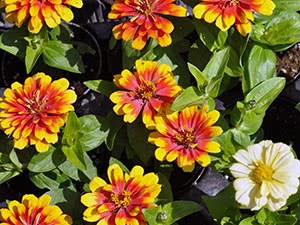 Zinnia (лат. Zinnia) belongs to the genus of herbaceous and shrubby perennials in the Asteraceae family, native to South Mexico, named after the pharmacologist and botanist Johann Gottfried Zinn from Göttingen, who being a director of the Botanic garden supplied Carl Linnaeus with the herbarium for research. The Aztecs cultivated zinnia from 1500, and in Europe it appeared in the 18th century, immediately becoming a favorite ornament of gardens and aristocratic receptions.
Zinnia (лат. Zinnia) belongs to the genus of herbaceous and shrubby perennials in the Asteraceae family, native to South Mexico, named after the pharmacologist and botanist Johann Gottfried Zinn from Göttingen, who being a director of the Botanic garden supplied Carl Linnaeus with the herbarium for research. The Aztecs cultivated zinnia from 1500, and in Europe it appeared in the 18th century, immediately becoming a favorite ornament of gardens and aristocratic receptions.
By the twentieth century zinnia has been cultivated on all continents, and from 1931 to 1957 the flower of zinnia was even a symbol of the state of Indiana, USA. Today there are about twenty species, many varieties and hybrids of this amazing flower, characterized by beauty and easy growing conditions.
Zinnia flowers – description
Depending on the species and variety, the height of zinnia can range from 8 to 39 inches and even higher. The leaves of zinnia are entire, sessile, ovate, with pointed tip, pubescent with hard hairs, and have verticillate or decussate leaf arrangement. Inflorescences are the apical single heads with a diameter of 1.2-5.5 inches, located on long peduncles. Imbricated in one or several rows semiflorets can be white, purple, orange, yellow, red, of any color, except for the shades of blue. Disc, tubular florets are small, yellow or reddish brown. The fruit is a seed with a pappus. Zinnia blooms from the middle of June till frost and has a high resistance to heat and drought. Zinnia plant is cultivated as a bright and unpretentious garden plant and a great cut flower. Perennial zinnia grows only in the regions with warm winters. In cold climate zone garden zinnia is an exceptionally annual plant, because it can not tolerate even the shortest and lightest frosts. This flower is sometimes called “major”. Annual zinnia and marigolds, chamomiles and common marigolds are the main flowers used in the countryside landscape that is increasingly becoming popular in Europe. Zinnia can also be grown on one flower bed along with so-called noble flowers as well as in the vegetable garden due to its remarkable ability to stretch upwards without creating a shadow.
Growing of zinnia from seeds
Sowing of zinnias
Perennial zinnias as well as annual zinnias are propagated generatively. In a warm climate, where there is no frost in May, planting of zinnia directly in the open ground is quite possible, but if in your area night frosts are common, you should know that zinnia seeds will die at 30 ºF. That is why experienced flower growers believe that it is better to grow seedlings and prepare them for outdoor life, and then you can plant zinnias into the ground with subsequent successful rooting. Before sowing, wrap zinnia seeds in a rag or gauze soaked in a rooting hormone in order to identify which of them are germinable and which are not. Fresh seeds germinate in a couple of days while it will take a week for the old ones to break the shell. At the end of March or the beginning of April, two or three germinable seed grains are sown freely at the depth of 0.4 inch into peat pots with a moist substrate that will subsequently help avoid an unwanted picking out. Sown zinnia is moistened and put in a bright place. The optimum temperature for germination of zinnia is 72-75 ºF. If everything is done properly, the sprouts will appear in a few days.

Zinnia seedlings
Young plants quickly form additional roots, and if there is elongation of zinnia seedlings, you should just add a little amount of soil into the pots. You should remember that zinnia seedlings require a bright scattered light, otherwise if growing in the shade they can turn into sick translucent sprouts. With a sparse seed sowing there is no need to prick out seedlings, besides zinnia does not like this procedure. At the end of May to make planting out of zinnia successful, you should get seedlings prepared by placing them outdoors for a short period of time.
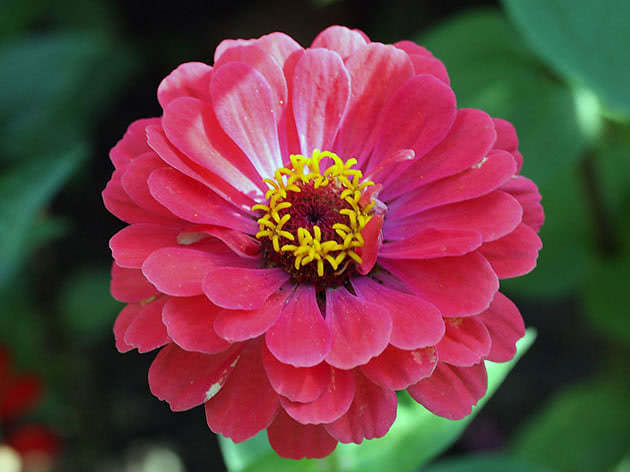
Planting of zinnia in the open ground
When to plant zinnia in the ground
When to plant zinnia in the open ground, or rather, when can seedlings of zinnia be planted out? Planting of zinnia in the ground is carried out in the second half of May, around the end of the month, when there is no threat of night frosts any more. The plant prefers light areas protected from the wind, with a neutral, well drained, nutrient soil. Before zinnia planting, weeds should be removed and the soil should be dug over to a depth of 17.7 inches with adding of leaf humus, compost or rotted manure at the rate of 17.6-22 pounds per 11ft², and it should be repeated in autumn.
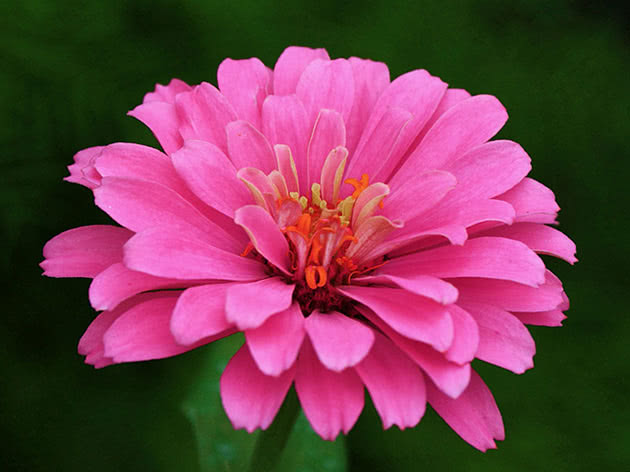
How to plant zinnia
Planting of zinnia flowers is carried out at a distance of 12-13.7 inches from each other by repotting or along with a peat pot. You will see zinnia flowering in early July.
Zinnia flower: care
How to grow zinnia
If zinnia planting is carried out successfully, the next step is a proper care that implies a regular soil loosening, weeding and infrequent but abundant root watering for the water not to fall on the flowers. When zinnia starts flowering, wilted flowers should be removed timely. Strong stems of zinnia do not need any support.
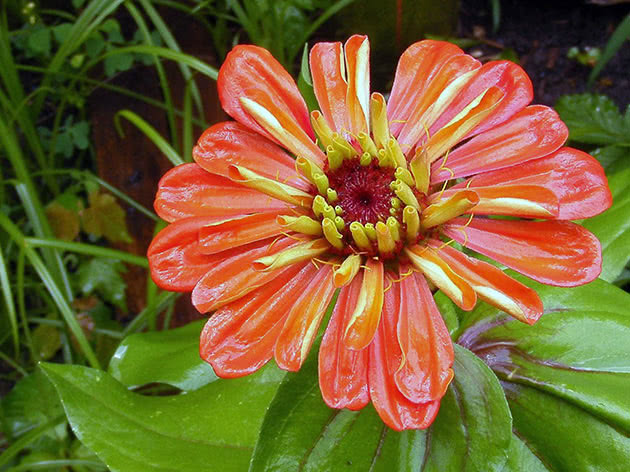
Zinnia fertilizing
When sprouts appear and until the time of zinnia planting in the soil, seedlings are fed with mineral fertilizers with a low nitrogen content three times. When planted out, zinnia is fertilized with mineral fertilizers or liquid manure at least twice a summer: the first time it is fertilized in a month after planting, and the second time is during the budding period. That's it. As you can see, planting and caring for zinnia are not burdensome.
How to nip off zinnia
Readers often ask whether to nip off zinnia or not, and if so, how and when it should be done. If you want zinnia to tiller, you need to nip off seedlings above the third or fourth pair of leaves, although you can do this when zinnia is already planted out in the open ground and takes roots. But if you want to grow elegant flowers on long peduncles for cutting, zinnia nipping is not needed.

Pests of zinnia
Among pests that bother zinnia there are aphids, may-bugs, snails and slugs. Gastropods are usually attracted by beer pans, placed around the site, or by the pieces of slate or roofing material scattered between the plants under which gastropods like to hide. They should be collected manually. May-bugs also have to be collected by hand and dropped into the bucket with a soapy water. Aphid is destroyed by spraying of zinnia with a tar soap solution at a rate of 0.35 oz per 1.75 pint of water, and in case of severe contamination treat the plant with a solution of insecticide or Actellic, as prescribed in the instruction.
Diseases of zinnia
Zinnia can be possibly affected by gray rot, vascular wilt, bacterial spotting, but more often by powdery mildew. If at least one leaf of zinnia has gray-brown spots of circular shape caused by bacterial spotting, you should immediately take measures: the leaves with the signs of the disease should be removed, if the infection is severe, destroy the whole plant since there is no cure for this disease. You should apply fungicides to get rid of gray rot, vascular wilt, and powdery mildew that demonstrates itself by a white coating on the ground parts of zinnia. It must be noted that the primary cause of diseases is violations of the rules of plant growing, for example, because of too thick planting or excessive watering, so the first you should diagnose the problem of zinnia, eliminate it, if possible, and then go over your mistakes – reread rules of plant care, find and analyze the discrepancies between the rules and the way the things are in fact. Only in this way you can avoid troubles in the future.

Zinnia after flowering
How and when to collect the seeds of zinnia
Seeds of zinnia ripen approximately in two months after the beginning of flowering, so mark a few inflorescences that started flowering the first. The shoots of the first order have the seeds of the best quality, so you should remove all lateral shoots of those plants that you have selected for seed ripening. When the heads get brownish, they are cut off, dried, the seeds are collected and cleaned from the dry remnants of flowers and stored in a dry place with a constant temperature. The seeds of zinnia retain their germination capacity for 3-4 years.

Perennial zinnia in winter
As it has been mentioned already, in the garden zinnia is grown as an annual plant. But if zinnia is not grown outdoors but in a container or pot, then with the onset of autumn place the flower in the room and treat it as an indoor plant, turning an annual zinnia into a perennial one.
Species and varieties of zinnia
Only four of more than twenty species of zinnia are cultivated: elegant zinnia, narrow-leaf zinnia, or zinnia haageana, zinnia tenuifolia, and zinnia linearis. The first two species were widely used for breeding, and, as a result, today in the gardens we cultivate not only the main species of zinnia, but also lots of fine varieties and hybrids of this plant.
Elegant zinnia (Zinnia elegans)
is a herbaceous annual plant, up to 3.3 ft in height with simple white, orange and pink inflorescences. The stem is straight, usually it is not branching, round in section, densely pubescent with hard hairs, all shoots end with apical inflorescence-heads. The leaves are sessile, smooth-edged, ovoid, with a pointed apex, 2-2.7 inches long and 1.2-1.8 inches wide, the leaf surface is pubescent as the stem. Inflorescences are from 2 to 6.3 inches in diameter, simple, semi-double and double, consist of semiflorets up to 1.7 inches long and 0.6 inch wide, of various colors, except for shades of blue, and middle, tubular flowers of yellow or reddish-brown color. Elegant zinnia starts blooming in June till frosts. In nature it mostly grows in southern Mexico. It has been cultivated since 1796. Varieties and hybrids of elegant zinnia are classified according to several criteria: the structure of the inflorescence, their shape, the height of the stem and the flowering time.
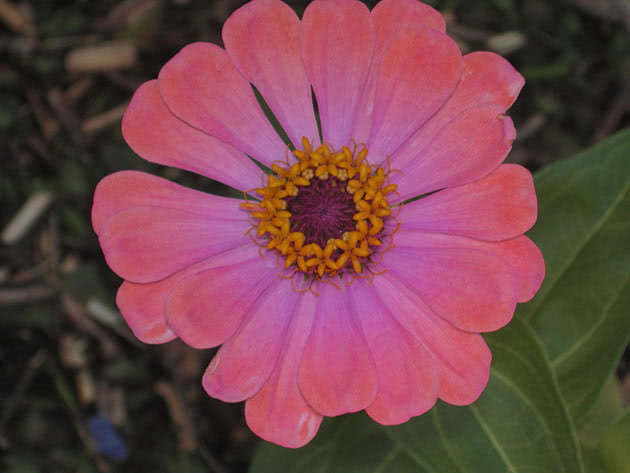
According to the flowering time, there are early-flowering, mid-flowering and late-flowering zinnia.
According to the structure of the inflorescences, zinnia varieties are divided into simple, semi-double and double.
Depending on the height of the stem there are:
- high zinnia (24-35 inches) is grown for cutting as it looks somewhat cumbersome on the flowerbed;
- medium-sized zinnia (14-20 inches) is suitable both for cutting and decorating of the flowerbed;
- dwarf zinnia, or low zinnia (6-12 inches) is a well branching bush, grown both on flowerbeds, in the balcony containers or just in the pots.
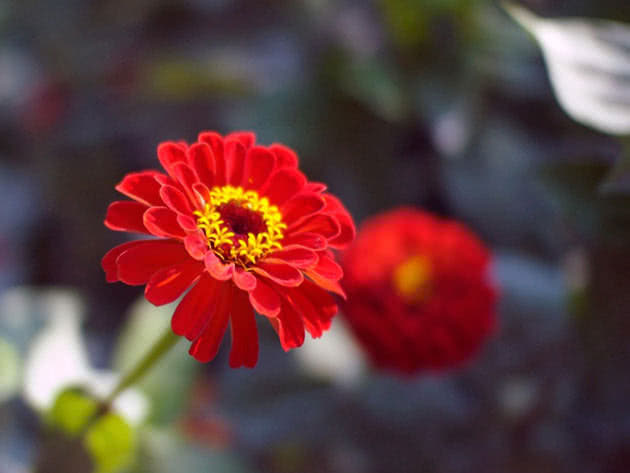
According to the shape of inflorescence zinnia species are classified into seven categories. In cold climate the following species are mainly grown:
- Dahlia-flowered zinnias are powerful shrubs, spreading or compact, with a height of from 24 to 35 inches with shoots of the first order. The leaves are large, up to 4.7 inches long, inflorescences are hemispherical, double, up to 5.5 inches in diameter. The varieties are: – Violet is a double zinnia, 24-29.5 inches in height with dense inflorescences of various shades of violet; - Orange King has the stems 24-28 inches in height and bright red-orange double inflorescences up to 6 inches in diameter; - Polar Bear is a compact plant up to 26 inches tall. Its inflorescences are white, fully double, with tints of green;
- Zinnia lilliput, or pompom zinnia is a compact branchy bush, not higher than 22 inches with a large number of shoots of the second, third and fourth order. The leaves are small. The inflorescence is up to 2 inches in diameter and resemble the shape of the pompom. The varieties are: - Little Red Riding Hood is a fully double variety, up to 22 inches high with bright red inflorescences of truncated-cone or round shape; - Tom Thumb is a compact shrub, up to 18 inches in height, with dense double red inflorescences in the shape of a slightly flattened ball; - Thumbelina is a mixture variety of different shades, the height of the bush is up to 18 inches and an inflorescence diameter is from 1.6 to 2.3 inches;
- Fantasy zinnia is almost spherical compact bush, 20-26 inches in height, with large leaves and loose curly inflorescences, in which narrow semiflorets are folded into tubes and bent in different directions, and the tips of some of them are bifurcated. The varieties are: - Fantasy is a bush up to 24 inches in height with double loose inflorescences up to 4 inches in diameter of different shades – violet, red, bright yellow, purple, red-orange, pink, white, salmon, etc .; - Gift is a bright red zinnia.
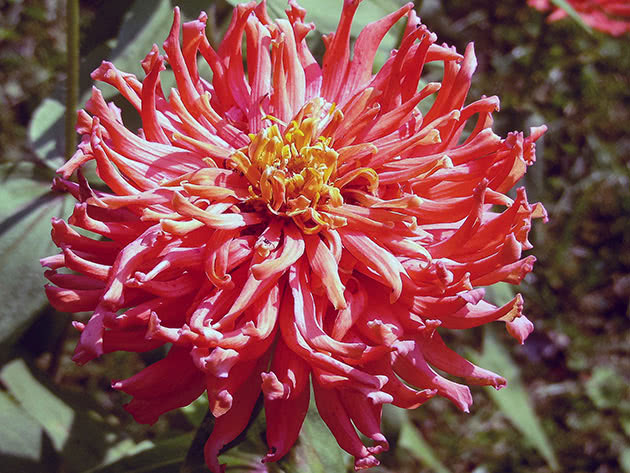
In other countries the following varieties are also popular:
- California Giant is a variety of double zinnia with a diameter of up to 6 inches, semiflorets are imbricated, the height of the stem is up to 3.3 ft and even more. They are characterized by a comparatively late flowering;
- Giant cactus-flowered zinnia is varieties from 2.5-3 ft in height with double inflorescences up to 4 inches in diameter, folded into a tube, the semiflorets are sometimes wavy with slightly raised tips;
- Super cactus-flowered zinnia is varieties with the same inflorescences as giant cactus-flowered zinnia has, but its height is less than 24 inches;
- Scabiosa-flowered zinnia (also anemone-flowered) is a mix of varieties with inflorescence up to 3 inches in diameter, in which semiflorets are arranged in one row around the center that consists of tubular flowers enlarged by corolla. This makes the center look like a hemisphere and it has the same color as the semiflorets.

Zinnia Haageana, or narrow-leaved zinnia (Zinnia angustifolia)
also comes from Mexico. This is an annual straight plant that forms branched bushes. The leaves are sessile, lanceolate or elongated, pointed. Inflorescences are small, simple or double, bright orange in color. The varieties are:
- Glory Shine is a heavily branched bush up to 10 inches in height, with double inflorescences, in which the semiflorets are dark orange at the base with red brown tips;
- Persian Carpet Mix with semi-double two-colored inflorescences of lemon, white, orange and yellow color with red tint. A large bedflower of this zinnia really looks like an oriental carpet.
- Starbright and Classic are also famous English varieties. These plants have white, yellow, orange inflorescences. A thin and weak but very branching stem has the height of up to 12 inches. These zinnias are mostly used as ground covering plants. Variety Sombrero look especially pretty on the flower bed. Its inflorescences are of a red-brown hue with an orange edge.

Zinnia tenuifolia
is usually used to create landscape flower beds. It is a bush of about 24 inches in height, with geniculate, thin stems of a reddish tint. Inflorescences are small, up to 1.2 inches in diameter, semiflorets are narrow, bent, with twisted tips, of a purple tint. One of the varieties is Red Spider.
Zinnia linearis)
is sometimes confused with narrow-leaved zinnia since it has thin and sharp leaves, like the tips of a nail scissors. This is the smallest of the cultivated species as branching, almost spherical bushes grow no more than 14 inches. Inflorescences of zinnia linearis are small, semiflorets are yellow with orange edges. Zinnia linearis is good for growing in pots, in balcony containers, on alpine hills and in small flower gardens. The varieties are:
- Golden Eye has white center consisting of tubular flowers, and white semiflorets. The variety looks like a common chamomile;
- Caramel has caramel-white semiflorets, the center is black.
- Yellow Star is a variety with yellow inflorescences.

By crossing of zinnia haageana and elegant zinnia a lot of new hybrids were bred such as the variety Profusion. This variety is very popular among the florists, its low shrubs are up to 14 inches in height, covered with small multi-colored daisies. The Magellan variety also acquires fame. Its shrubs are up to 14 inches in height, with fully double, dahlia-liked inflorescences up to 4 inches in diameter. The color is coral, cream, orange, pink, red, cherry, salmon and yellow. A new series Swizzle comprises two varieties – Cherry Ivory with cherry heads with cream-colored tips of semiflorets and Scarlett Yellow with red inflorescences and bright yellow tips.
